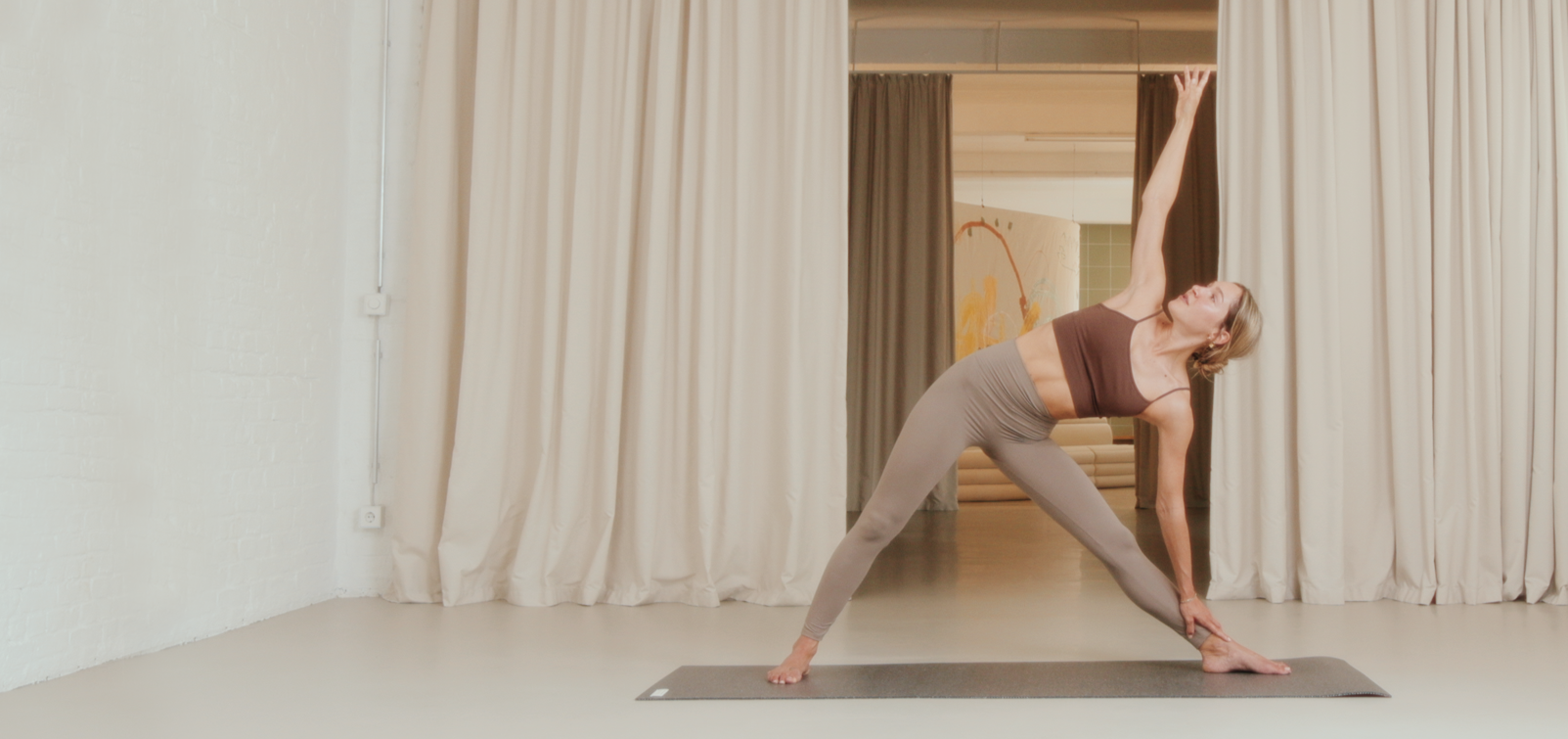This guest article was written by a specially trained trauma sensitive yoga teacher. Loredana Di Filippo offers (trauma)sensitive 1:1 sessions and workshops and works with traumatized people. Her work is based on the understanding of the autonomous nervous system. Das daraus resultierende Wissen ist für alle spannend, die feinfühlig sind, wirklich Veränderung in ihr Leben einladen wollen und dafür tief, auf der Ebene des autonomen Nervensystems ansetzen wollen. Thank you for sharing your knowledge with us, Loredana.
In this article, I want to explain to you why more people are affected by trauma than you might think. I’ll also explain what trauma sensitive yoga is, how you can recognize a trauma-sensitive yoga class as a student, and what you should look for if you want to teach trauma sensitive yoga.
Trauma sensitive yoga: What is trauma?
Before I go into what potential trauma sensitive yoga teaching has and what a trauma sensitive yoga class looks like in concrete terms, I want to briefly address the question of what trauma actually is. I am only touching on this topic because otherwise the article would become too extensive, and will be focusing particularly on the distinction between shock trauma and developmental trauma.
Shock trauma
When people think of trauma, they think of war, natural disasters, accidents, or sexual violence. It’s true, of course: these events have the potential to be traumatic. Shock trauma is an event that happens unpredictably and is overwhelming. They are singular, self-contained events that are beyond our resources. The event does not necessarily have to be life-threatening. Even surgeries or breakups can be traumatic. Classic symptoms of shock traumas are, of course, things like flashbacks, dissociation, and intrusions. But it’s also, or even especially, the symptoms that I’m about to bring up in the context of developmental trauma that cause problems for people with shock trauma. This has to do with the fact that trauma interferes with our ability to self-regulate. I’ll explain the function of self-regulation in this article as well.
Developmental trauma
But does trauma “only” have something to do with war and violence? Symptoms such as sleep disorders, restlessness, nervousness, anxiety, panic, volatility, severe exhaustion, a lack of self-worth, fits of rage, panic, smoking, sex addiction, depression, or general difficulties in getting and staying connected can also be possible consequences of trauma (the emphasis is on “can“).
Developmental trauma occurs when a young organism is overwhelmed for an extended period of time. If their primary caretaker cannot care for them properly, then this can be traumatic for a child. There are numerous reasons why a child cannot develop properly in this world. In the past, for example, people thought that it was only good for the child if you just let it cry. But children up to a certain age can neither regulate themselves nor learn from such an experience. For the child, such an experience is traumatic. Lack of care and attachment are the breeding ground for developmental trauma. This trauma, which is much more common than shock trauma, is not about a single event, but about many events that affect the child’s development.
If parents themselves have experienced traumatic events and are not able to be there for themselves and their children, then this is traumatic. Other strokes of fate also contribute to early childhood imprinting.
Trauma sensitive yoga: Self-regulation
The ability to switch between tension and relaxation determines how well we live. Neurobiologically, this ability is called self-regulation. Self-regulation is a function of our autonomic nervous system (ANS) that ensures that our ANS can fulfill its task. This is because it ensures our survival by adapting to the demands of a situation. Things that create more energy than our ANS can hold have the potential to unbalance our ability to self-regulate.
When we come into the world, our ANS is not yet fully developed. We learn regulation by having our primary attachment figure teach us regulation and help us develop this ability that is naturally built into us. Therefore, ideally, our primary caretaker’s systems should be well regulated. But often they are not. This is no one’s fault except perhaps the complexity of this world.
The ANS of people who have experienced trauma is out of balance. But you don’t have to be traumatized for your ANS to be out of balance. The knowledge of self-regulation is helpful to all who have a nervous system. Thus, it affects all of us.
Collective Dysregulation
It is considered dysregulation if your nervous system only switches between parasympathetic and sympathetic very abruptly. And frankly speaking, that behavior is socially acceptable in our society. Many people constantly and often unconsciously live at the limit of what they can bear. Some people are addicted to stress and thus experience the tension and insecurity they may have grown up with over and over again. Because of what we know, our nervous system evaluates as safe. After a stressful experience, there is often no smooth transition into relaxation, but we collapse into lethargy and have to eat, watch, drink, smoke something to finally switch off.

What is trauma sensitive yoga?
Now we’ll look at what trauma-sensitive yoga is, how you can recognize a trauma-sensitive yoga class as a student, and what you should look for as a yoga teacher if you want to teach trauma-sensitive.
If you want to teach trauma sensitive yoga, you should be trauma-informed. Because teaching trauma sensitive is not a style, but an attitude. I also feel it is important to know about the autonomous nervous system (ANS). If we understand how the ANS works, then we can better understand and work with our symptoms.
Cathartic methods that are not trauma-informed have the potential to destabilize the person. As a student, you should become attentive when the lesson is about persevering, enduring, and continuing against your sensations.
You can practice this in trauma sensitive yoga:
There are no specific exercises for trauma. But there are things you can do to strengthen your resources:
- You can (re)learn self-regulation.
- It is possible for you to make friends with your body.
- You can sense and strengthen your boundaries.
This is what trauma sensitive means in concrete terms
Actually, with trauma-informed guidance, all exercises can be done. What is important is that you acknowledge that trauma is in the body. Working with the body has the power to strengthen the system. However, a movement that releases more energy than the person can hold, very intense mobilization, ecstatic methods, and long periods of stillness could also be destabilizing. Of course, this always depends very much on who is practicing and what history you or your students bring with them. Compassionate teaching that is not performance-oriented is therefore essential.
Your eyes may stay open!
“Close your eyes.” This request often means the first overload in a yoga class for people who carry great insecurity, tension and stressful memories. Trauma means that something was too much for the person. For a system that carries a lot of anxiety, it is very counterintuitive and sometimes even torturous to close the eyes and meditate, for example. This does not mean that some people can never close their eyes. I have had many clients who had no problem with this at all. As a student and/or when you work with people, just know that this can be an issue. You can always keep your eyes open. Often in yoga we are taught to focus our view so that we can also focus our mind. Feel free to let your mind wander during the yoga class, as this can also create safety. Orient yourself in the room and feel that there is no danger here.
Conditions that promote safety
I assume that my presence can initially appear dangerous to my counterpart. Trauma means a disconnection to ensure one’s own survival. We always say, “Yoga means connection.” But this is not trivial. For many people, coming into connection means healing and triggers incredible fear. That’s why I stay on my mat during the session, don’t touch anyone without permission (even though I’m convinced that touch can be very healing in itself) and announce when I’m opening the window, for example.
A trauma sensitive choice of words:
In my first yoga teacher training, I learned not to say words like “maybe” too often. “Maybe you feel something like security now.” That is far too imprecise and speaking in contingencies makes no sense. Either I want to suggest to the students that they feel secure, or they don’t. Today I teach on the basis of “maybe”. In my experience, words that evoke a feeling of lightness in you can evoke unpleasant to terrible memories in others. Because words are powerful. Of course, you can’t prevent yourself from upsetting people with your choice of words. But by using very inviting non-suggestive language, you can create a space of safety.
“You have a choice.”
This is the message that teaching should convey. When someone has experienced trauma, and it doesn’t matter to the brain whether it’s a serious accident or a troubled childhood, the person actually always carries the belief that he or she has no choice.
The focus on the breath can be a trigger:
The breath is your friend and gives you information about your autonomic nervous system. Through the breath, you also have direct access to your autonomic nervous system. In people with developmental, attachment or shock trauma, the autonomic nervous system is out of balance. This is reflected in breathing. One of the first questions I ask my students and clients in 1:1 sessions is, “How do you relate to your breath?” Often it turns out that the breath is shallow and superficial. A direct expression of restlessness and an amplifier of symptoms such as anxiety, tension and insomnia. By working with the breath, we can work wonderfully with the nervous system. But the rule is the slower, the better! Tension and associated emotions want to be touched as gently through the breath as an infant.
Savasana
I encourage my clients to go in search of safety. What position triggers safety in you? Is it the supine position? Wonderful! Is it the prone or side position? Follow your needs. Again, give your students a choice. If you are participating as a student remember: It’s important that you feel safe and held.
Because in the end, it’s about finding safety. Only when we feel safe to change can take place.

How to calm your nervous system
What can help you calm down depends on what you bring to the table. It’s hard to generalize here. For one person, exhaling over a slightly open mouth is calming. For another, the free expression of breath is shameful. There are countless things you can do when you feel a lot of restlessness in you. I would like to introduce you to three of these now:
- When you have too much going on inside – Explore the space with your senses: It’s the opposite of what our body does when it’s stressed. We experience the world and get our eyes stuck on what seems positive or aesthetic. Water, the sea, sunsets – it’s not without reason that so many people enjoy them. So exploring the world with our senses, signals to our body that we are safe. When our body is in danger either actual or felt (our body does not discriminate in its reaction), then this “exploring the world” gives way to defensive behavior – makes sense.
- Sometimes, however, overexcitement arises because the outside is too much. Then it can help to find a position in which you feel safe. Try everything that comes to your mind. Maybe you want to lie down and feel the ground beneath you. Maybe you want to get really small, curl up, and get into the side position. Sometimes it helps to weigh yourself down with a few pillows to feel gravity better. Or you might get into a tabletop position. Spürst du, wie deine Hände den Boden oder deine Yogamatte berühren?
- A long exhalation activates the parasympathetic nervous system. However, you should start working with your breath before you get into internal distress. If your nervous system is very overexcited, suddenly interfering with your breathing pattern can be uncomfortable. But again, try it out! When you learn to make friends with your breath, you have the opportunity to work with your nervous system through breathing. Many people find 4:4 breathing helpful. You breathe in on 4 and out on 4. You breathe normally, without deepening the breath excessively.
Thank you for your curiosity!
This was a really short introduction to the infinitely wide field of trauma sensitive yoga. Of course, in such a context, I cannot address all aspects as I would like to. Therefore, I am very happy if you share your questions and comments with me. You can contact me here.
Loredana
Find on Instagram 5 more ways to calm your nervous system.





